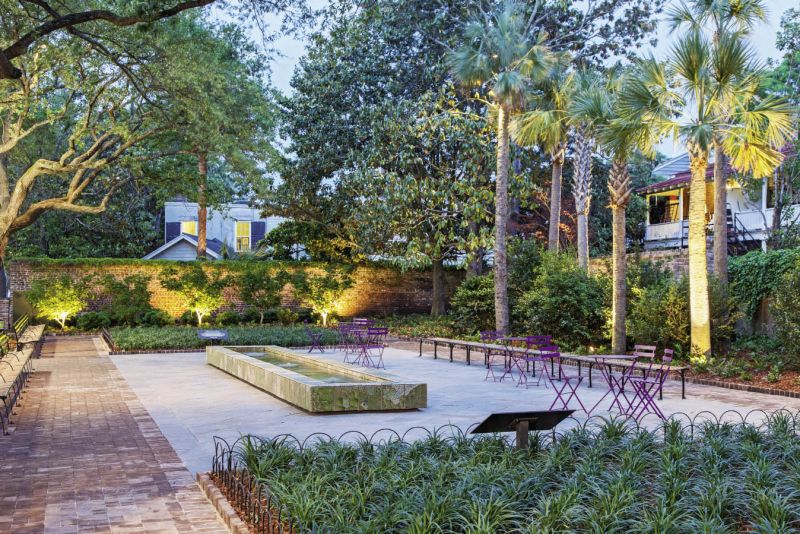
“Around midday, a middle-aged African-American woman walked into Theodora Park. She strolled right over to one of the purple bistro chairs, picked it up, moved it into the shade, and sat down with an apparent sense of great relief,” recalls David Rawle of an occasion soon after the City of Charleston space opened on June 6. “She seemed to feel welcome, comfortable, and at home. My mother, for whom the park is named, would be absolutely delighted. As am I.”
A place folks would treat as though it were their own home: that’s just what Rawle imagined when he conceived of this park at the corner of George and Anson—across the street from the new Gaillard Center—years ago. Back then, it was the Ansonborough Tot Lot, an overgrown, rarely used playground. Living around the corner, the now-retired founder of marketing and communications firm Rawle Murdy wished to transform it into a tranquil place of beauty, blending nature and art while honoring his mother, an avid gardener.
“I hope this catalyzes others to consider creating or improving green spaces in their neighborhoods.”
—David Rawle
To bring his vision quite literally to life, he hired esteemed local landscape architecture firm Wertimer & Associates to create a design he presented to the city. Using three existing live oaks as the foundation, Sheila Wertimer dreamed up what she calls “a lush and tranquil public garden,” incorporating palmetto trees; flowering plants like camellias, azaleas, and redbuds; and beds of holly ferns and lilyturf. Traditional bluestone and brick paving in a unique basket-weave pattern surround the park’s centerpiece, a fountain pool lined with 370 tiles handmade by ceramic artist Paul Heroux.
“The look of the tiles through the water changes constantly, depending upon the hour, the light, the wind,” says Rawle. “There’s so much variety, so many possibilities. And that’s what art is all about—seeing things anew and differently, helping us discover life’s possibilities.”
For comfortable contemplation, Rawle got permission from New York’s Battery Park to reproduce their River Benches, which feature curved wooden seats, and brought in purple bistro tables and chairs (staffers at Zero George Street hotel carry them inside each night).
Unexpectedly, he also got the chance to purchase a gate that iconic Charleston ironworker Philip Simmons designed and made in the early 1980s for his insurance agent’s home in West Ashley. Rawle rallied extra funds in order to snap it up, and local architect Jim Thomas donated his services to design a base for its display.
In total, Rawle privately raised $462,000 that was donated to the Charleston Parks Conservancy, earmarked for Theodora Park, and the City of Charleston contributed $100,000. “I hope this catalyzes others to consider creating or improving green spaces in their neighborhoods,” he says.
Eleven days after Theodora Park was dedicated, the horrific murders at Emanuel AME Church took place. Just two blocks away, the lush spot quickly “became a place of solace,” notes Rawle. “I’ve seen people of all ages and races chatting together there. Now more than ever, we need places of respite where we can gather our thoughts, talk with someone else, or simply draw comfort from nature and art.”